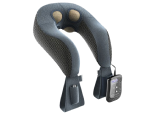Your circulatory system is responsible for delivering oxygen and nutrients throughout your body. When this process is compromised, you may experience uncomfortable symptoms that impact your daily life. Indeed, poor circulation affects millions of people worldwide, yet many don't recognize the early warning signs until symptoms become severe.
Poor circulation is a common issue, particularly among older adults. About 12–20% of people over the age of 60 are affected by peripheral artery disease (PAD), a leading cause of poor circulation in the lower extremities (Clin Cardiol.) The good news? Many circulation issues can be managed effectively with the right approach, including lifestyle changes, medical care, and innovative technologies like DR-HO'S advanced stimulation therapy.
What is Poor Circulation?
Circulation refers to the continuous flow of blood throughout your body, powered by your heart and facilitated by a complex network of arteries, veins, and capillaries. When this system doesn't function optimally, certain areas of your body (particularly your hands, feet, arms, and legs) may not receive adequate blood flow.
Poor circulation isn't a disease itself, but rather a symptom of underlying conditions. It can result from various factors including diabetes, peripheral artery disease, blood clots, varicose veins, and lifestyle factors like smoking or prolonged sitting.

10 Warning Signs of Poor Circulation You Shouldn’t Ignore
Understanding the early signs of circulation problems can help you seek appropriate care before symptoms worsen. Here are the key poor circulation symptoms to watch for:
1. Numbness and tingling
The most common sign of poor circulation is numbness or a "pins and needles" sensation, especially in your hands and feet. This occurs because reduced blood flow limits the oxygen supply to nerve tissues. If you frequently experience numbness that doesn't resolve quickly, it may indicate circulation issues.
2. Cold hands and feet
When blood can't reach your extremities effectively, these areas feel noticeably colder than the rest of your body. Your hands and feet are farthest from your heart, making them particularly vulnerable to circulation problems. Pay attention if your fingers and toes feel cold even when the rest of your body is warm.
3. Persistent fatigue and weakness
Poor circulation means your muscles and organs aren't receiving optimal oxygen and nutrients. This can lead to chronic fatigue, muscle weakness, and feeling drained even after adequate rest. If you're experiencing unexplained tiredness that affects your daily activities, circulation issues could be a contributing factor.
4. Swelling in lower extremities
When circulation is compromised, fluid can accumulate in your legs, ankles, and feet, causing noticeable swelling. This happens because your circulatory system struggles to return blood and lymphatic fluid back to your heart efficiently.
5. Muscle cramping and pain
Inadequate blood flow to muscles can cause cramping, especially in your legs and feet. This pain often worsens with activity and may be accompanied by a throbbing sensation. Many people experience leg cramps that become more frequent over time.
6. Slow wound healing
Your body needs adequate blood flow to repair tissues and fight infection. When circulation is poor, cuts, scrapes, and wounds heal much more slowly than normal. This is particularly concerning for people with diabetes, who may be at higher risk for serious complications.
7. Skin color changes
Poor circulation can cause noticeable changes in skin appearance. You might notice pale, bluish, or grayish discoloration, particularly in your fingers, toes, or nail beds. These color changes indicate that tissues aren't receiving sufficient oxygenated blood.
8. Hair loss on extremities
Hair follicles require good blood flow to remain healthy and continue growing. If you notice unusual hair loss on your arms or legs, it could signal circulation problems in those areas.
9. Cognitive difficulties
Your brain requires consistent blood flow to function optimally. Poor circulation can lead to difficulty concentrating, memory problems, or feeling mentally "foggy." These cognitive symptoms often improve when circulation is enhanced.
10. Digestive issues
Your digestive system also depends on adequate blood flow. Poor circulation can contribute to digestive problems, including reduced appetite, irregular bowel movements, and general gastrointestinal discomfort.
Understanding The Causes
Several conditions and lifestyle factors can contribute to poor circulation:
Medical conditions:
-
Peripheral artery disease or peripheral arterial disease (PAD)
-
Diabetes and diabetic complications
-
Heart disease and high blood pressure
-
Blood clots and deep vein thrombosis
-
Varicose veins
-
Raynaud's disease
Lifestyle factors:
-
Smoking and tobacco use
-
Sedentary lifestyle and prolonged sitting
-
Obesity and excess weight
-
Poor diet, high in sodium and processed foods
-
Chronic stress
-
Dehydration
How DR-HO'S AMP 4-in-1 Technology Supports Circulation
At DR-HO'S, we've developed innovative technology that works with your body's natural processes to help boost blood flow, improve local circulation, and provide temporary relief from circulation-related discomfort. Our proprietary AMP 4-in-1 Technology represents a breakthrough in electrical stimulation therapy.
The Science behind AMP Technology
Our unique approach combines four proven therapeutic modalities in one advanced system:
-
TENS (Transcutaneous Electrical Nerve Stimulation): Uses gentle electrical pulses to work with your nervous system, helping to block pain signals and promote the release of your body's natural pain-relieving chemicals.
-
EMS (Electrical Muscle Stimulation): Delivers targeted stimulation to muscle groups, encouraging muscle contractions that can help enhance local blood flow through natural muscle pump action.
-
NMES (Neuromuscular Electrical Stimulation): Focuses on the interaction between nerves and muscles, promoting coordinated muscle activity that supports healthy circulation patterns.
-
Auto-Modulating Pulses: Our proprietary technology automatically adjusts stimulation patterns to work more effectively with your body's natural responses, ensuring optimal therapeutic benefits while maintaining comfort. Auto-Modulation delivers 300+ soothing stimulations.

How it works for circulation
Recent clinical research (Scand J Plast Reconstr Surg Hand Surg) demonstrates that electrical stimulation can have positive effects on circulation. Low-frequency electrical stimulation has been shown to increase local blood flow, while muscle stimulation can enhance the natural pumping action that helps move blood through your circulatory system.
DR-HO'S AMP Technology works by:
-
Encouraging muscle contractions that help pump blood through your circulatory system
-
Stimulating sensory nerves that can influence local blood vessel function
-
Promoting the release of natural substances that support healthy circulation
-
Activating muscle pump mechanisms that assist venous return
-
Supporting the body's natural pain management systems to help you stay more active
Our devices are designed with user-friendly features that make it easy to incorporate circulation support into your daily routine. With adjustable intensity levels, multiple program options, and comfortable electrode placement, you can customize your therapy to meet your specific needs. Plus, our technology is designed to be safe, non-invasive, and easy to use at home, making it a convenient complement to other circulation-supporting activities.
Comprehensive Strategies for Better Circulation
While DR-HO'S technology can be an excellent tool for supporting circulation, it works best as part of a comprehensive approach:
Stay active
Regular physical activity is one of the most effective ways to improve circulation. Even gentle activities like walking, swimming, or yoga can make a significant difference. Aim for at least 30 minutes of moderate activity most days of the week.
Maintain a healthy diet
Focus on foods that support cardiovascular health, including:
-
Fruits and vegetables rich in antioxidants
-
Omega-3 fatty acids from fish and nuts
-
Whole grains and fiber-rich foods
-
Plenty of water to maintain proper hydration
Manage your weight
Maintaining a healthy weight reduces the strain on your circulatory system and can significantly improve blood flow, especially to your extremities.
Avoid smoking
Smoking is one of the most significant risk factors for circulation problems. If you smoke, quitting is one of the best things you can do for your circulatory health.
Practice good posture
Avoid sitting or standing in one position for extended periods. Take breaks to move around, and consider compression socks if you must sit for long periods.
Manage stress
Chronic stress can negatively impact circulation. Practice stress-reduction techniques like deep breathing, meditation, or gentle exercise.
When To Seek Medical Attention
While many circulation issues can be managed with lifestyle changes and supportive therapies, it's important to consult with a healthcare provider if you experience:
-
Severe or persistent pain in your legs or arms
-
Non-healing wounds or ulcers
-
Significant swelling that doesn't improve with elevation
-
Sudden onset of severe symptoms including chest pain or shortness of breath
-
Signs of blood clots (sudden pain, swelling, warmth, or redness)
Early intervention can prevent circulation problems from becoming more serious and help you maintain an active, comfortable lifestyle.
Moving Forward With Confidence
Poor circulation doesn't have to limit your lifestyle. By recognizing the warning signs early, making appropriate lifestyle changes, and utilizing innovative technologies like DR-HO'S 4-in-1 AMP system, you can take proactive steps to support your circulatory health.
Remember that improving circulation is often a gradual process that requires consistency and patience. The combination of regular physical activity, healthy lifestyle choices, appropriate medical care when needed, and supportive technologies can help you maintain better circulation and enjoy a more active, comfortable life.
Your circulatory system works tirelessly to keep you healthy—give it the support it deserves with proven strategies and innovative technology designed to work with your body's natural processes.
Disclaimer: DR-HO'S content is intended for informational purposes only and should not be taken as medical advice. Please consult a certified medical professional for diagnosis and treatment recommendations.
















